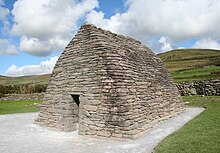Gallarus Oratory
| Gallarus Oratory | |
|---|---|
| Séipéilín Ghallarais | |
 |
|
| Location | Dingle Peninsula, County Kerry |
| Country | Ireland |
The Gallarus Oratory (Irish: Séipéilín Ghallarais, Gallarus being interprted as either "rocky headland" (Gall-iorrus) or "house or shelter for foreigner(s)" (Gall Aras), is a chapel located on the Dingle Peninsula, County Kerry, Ireland. It has been presented variously as an early Christian stone church by its discoverer, antiquary Charles Smith, in 1756, a 12th-century Romanesque church by archaeologist Peter Harbison in 1970, a shelter for pilgrims by the same in 1994. The local tradition prevalent at the time of the oratory's discovery attributed it to one Griffith More, being a funerary chapel built by him or his family at their burial place.
The oratory overlooks the harbour at Ard na Caithne (formerly also called Smerwick) on the Dingle Peninsula.
There exist several interpretations as to the origin and meaning of the Irish placename Gallarus. Archaeologist Peter Harbison ventures the meaning to be something like "the house or shelter for foreigner(s)" (Gall Aras), the said foreigners being possibly "these pilgrims that have come from outside the Peninsula."
However, for lexicologist Pádraig Ó Siochfhradha (aka An Seabhach), the name does not refer to a foreign settlement but to a rocky headland » (Gall-iorrus).
The oratory is built of large cut stones from the Dingle Beds of the Upper Silurian Old Red Sandstone. Charles Smith, who discovered the edifice in 1756, described the stone as "a brown free-stone, brought from the cliffs of the sea shore, which cuts readily and is very durable."
The stones are cut on every side and end so as to fit perfectly together. They exhibit smoothly finished outside facings that follow the slant of the wall.
The edifice is usually thought to have been built without mortar, but there is evidence that even if mortar "was never visible in the wall facings it was used as a structural medium for the interior of the wall at least." A thin layer of lime mortar is used to bond the stones together and to fill in small hollows in the inner faces.
...
Wikipedia

